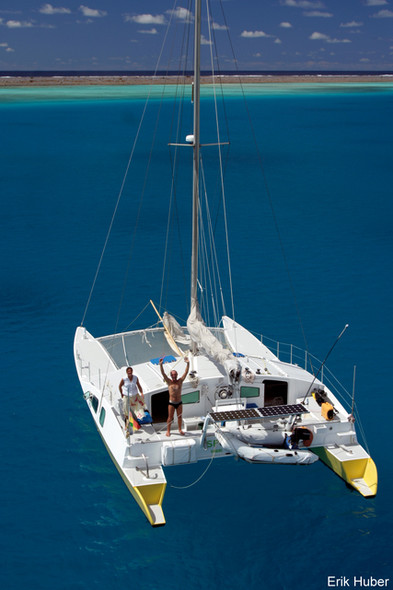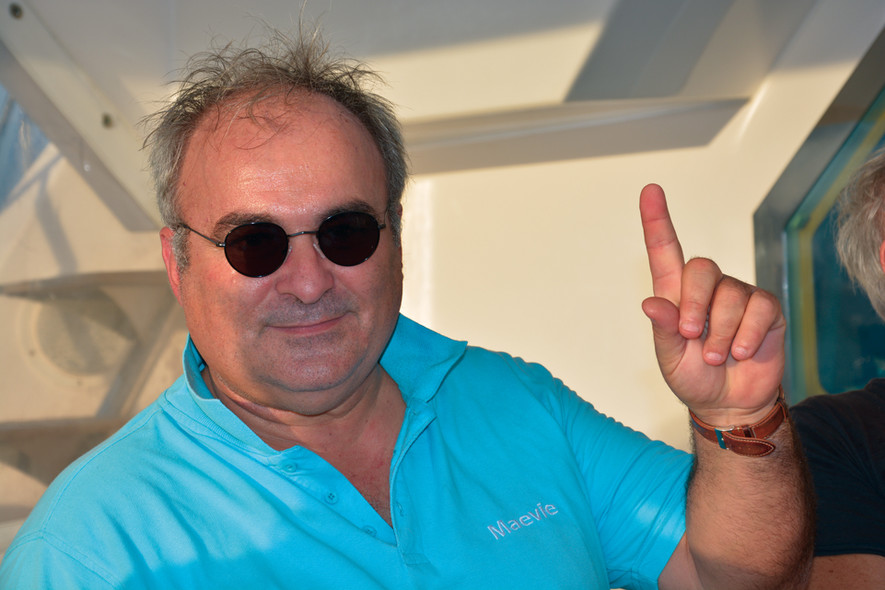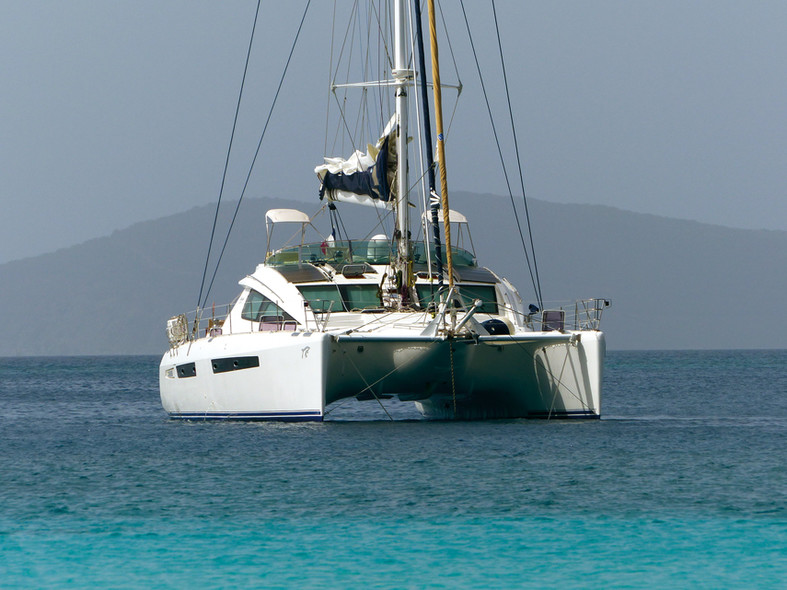
Issue #: 146
Published: March / April 2016
- Price per issue - digital : 5.40€Digital magazine
- Access to Multihulls World digital archives Digital archives
Spent his youth around the Cannes sailing school, making several delivery trips between Oran and Marseille on board a Tahiti Ketch (a wooden 9m Norwegian by John Hannah, the sistership of Jean Gau's Atom). Baltic Sea cruises, regattas and then a single-handed run between Martinique and Venezuela on a V500: a small 5m plastic-hulled yacht, with no radio, charts, fridge, dinghy or… budget: an adventure which he still holds dear! Later he was captain of Grand Bleu CNB 76', of Victoria T CNB 105', Only Now CNB 104' (shipyard trials and client handover). Later he was project leader at Palmer & Johnson USA (the refit of the "Charisma" Feadship 145'), followed by a new construction with CNB, the Frers 104' all carbon: at the time, the largest one-shot infused carbon canting keel and hull. With Sylverstake: the refit of the "Phocea", with Composite Works: the refit of the Perini Navi 53m Jasili II. He is currently Production Coordinator for Pinmar at Nobiskrug (painting of the Titan and Extasea, 80 and 86m).
"I've just finished a round the world trip, which has been 7 years of wild ocean sailing, meeting amazing people and seeing some incredible places. "Sputnik", my small 11.50m catamaran (a lightweight 3.8t) is fast and simple: designed and built by Marc Ginisty in 1987, it gave me the opportunity to take on this challenge. Would I take it on again in the same boat? The answer has to be yes! When I bought this little boat I certainly had some doubts and concerns. However, after having completed my journey, I am now convinced of the advantages of a basic multihull. A boat's basic qualities, whatever its size, are that It should be seaworthy and safe: In a small multihull, security is linked to speed. You need to be able to move quickly to avoid the bad weather! Throughout my trip, which took us as far as New Zealand and then South Africa, I never sailed in more than 40 knots of wind. During our return transat, we navigated precisely along the southern rims of two depressions, with storms to port and sunshine on our starboard side, before meeting a weather system which took us to the Azores! This required good up to date weather information (Grib-files via Iridium) and a fast boat which could get us to where we needed to be: to accomplish this you need to be light. A light multihull moves easily across the seas and its structure suffers less stress. There is the great pleasure of steering and guiding the vessel into the trough of the waves and then surfing on never ending rollers. In light airs, the large reacher helps the boat to effortlessly slip along for day after day: pure pleasure! On board Sputnik, we don't really have the choice, as the only motorized power is supplied by a single, centrally-mounted Yamaha 9.9 outboard. But what the heck, you just need to haul in the sheets and the turbo kicks in! The boat's other great quality is its reliability. I met many sailors stuck for weeks at shipyards waiting for a spare part or an electronic chart. Strangely this seemed to be the number one topic of conversation amongst the sailing community. To avoid these situations, I chose simplicity. No fridge or oven, no generator or 220V circuitry; no internal shower or hot water! It's great. Nothing can break down, the boat is lighter, and my crew were thrilled with the adventure throughout the duration. What you lose in terms of material comfort, is more than compensated by the close contact with nature and with the elements, and the joy of discovering real sensations and just enjoying a remarkable adventure. In these eco-friendly times, we should perhaps be prepared to admit that the best way to respect our environment is to reduce our energy consumption and lower our material needs. We manage to redirect those resources which are usually spent buying and maintaining a boat which is as complex as a house, into sailing, exploring incredible depths, swimming with sharks, climbing around lost islands, meeting people from far flung countries, looking for fruit in the jungle and many more things. In the light of these experiences, I think that the ideal multihull should be light, well-designed with a high skiff to avoid slamming, a low roof to reduce drag by improving close-hauled performance, and being as technically simple as possible. This way the boat can offer security through its dynamic qualities, the pleasure of sailing thanks to the great performance, and relatively easy maintenance thanks to the simplicity. There's no shortage of choice and it all depends upon your budget: adventure awaits at the end of the dock.
57 years old. Self-taught. He has been sailing since the age of 8. Organized sporting events from 1980 to 1991. Created a company involved in data and chip and pin cards from 1993-2009. Launched a French company manufacturing electric, folding bikes from 2010-2013. Currently involved in a digital management start-up linked to counterfeit protection.
"Twenty years ago I bought my first catamaran, to encourage my wife to come sailing with me. The internal volumes of a multihull corresponded to her idea of a living space, so I didn't have much choice! I wasn't trying to be flash. It's just that several experiences have seen me go from a 40' to a 46', then from a 49' to a 57', a 62' and finally a Privilege 615. Our cat is a place to share and to have fun with our friends and their children when they come to visit us. To ensure a harmonious collective existence on board, everyone needs somewhere to spend some quiet time, without having to be surrounded by people 24 hours a day, both outside and inside. To make this possible, the size of the boat is crucial. The Privilege 615 cabins certainly live up to their names: guests have plenty of room to stow their luggage and enough private space so that they don't have to share showers or toilets. The galley is obviously central to the quality of life on board. Cooling units and cupboard space need to be sufficiently large to maintain the good humor of the crew and to ensure that good meals are possible throughout the duration of the cruise. As the crucial "apéro" time can carry on for a while, a good supply of ice cubes is vital! Electrical autonomy is also another major factor: if you have to declare a blackout two hours after sunset (especially in the Caribbean), life becomes unbearable. The space available on a 60 footer can easily house a generous battery bank, a generator and some solar panels, without it taking up too much space or being too heavy. We regularly spray certain areas with fresh water: the sugar scoops after swimming, the cabin toilets at the start and end of each day, cooking and dish washing. The capacity of the watermaker's tanks mean that we don't need to worry about the water usage. The first few times, at the helm of my previous boat, a Lagoon 620, I was worried that I had bitten off more than I could chew. My friends thought I was mad. Today, those fears are gone, but I am still careful to over-anticipate any maneuvers, whether out at sea or in port. On board a catamaran you do need to resist the temptation to overload with any old stuff, and you should make sure that you respect the all-important payload: overloading can seriously impair your sailing. However, when setting out for a long sail, it is useful to have all the necessary tools, and some spare parts: you can guarantee that the worst problems won't happen in the port right outside the spare part specialists! On small cats, access to the mechanical parts can be difficult. Changing a drive belt drive in a small, cramped hull can be tricky, and getting things done quickly is essential.
There's no doubt that if I am racing against a smaller vessel, it will take me longer to hoist the mainsail, but the length of the floats means that sailing is much more comfortable in choppy waters. On a small cat, the jerky reactions can become unpleasant for the crew and stressful for the gear: a low bridgedeck clearance will result in more impacts. The height and size of the freeboard and the volume of the hulls on a larger boat help to avoid burying the bows or pitchpoling in heavy seas; moving around on the deck is less risky, and electric winches and furlers also allow you to react more quickly. This one-sided view of large cats is based upon my own personal vision of life on board a multihull, where the keys to enjoyable sailing are conviviality and safety".




What readers think
Post a comment
No comments to show.